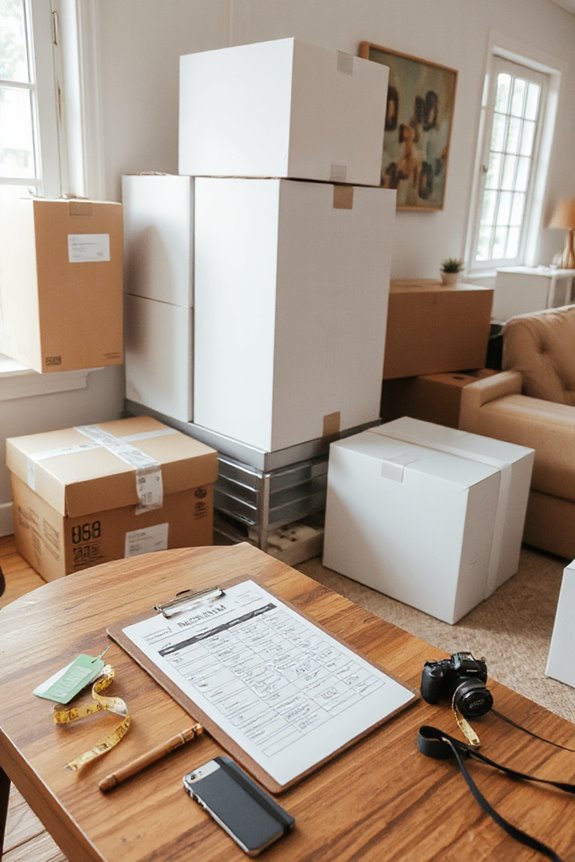To prepare your furniture for a long-distance move, start by cleaning and inspecting everything. Did you find any scratches or fragile parts? Disassemble large pieces to make transport easier, and don’t forget to label those parts! Next, create an inventory list to keep track of items and their conditions—who wants to lose track of their favorite chair? Gather protection supplies like furniture pads and bubble wrap. Want to know the best wrapping techniques for those delicate items? Stick around to find out!
Key Takeaways
- Clean and inspect furniture for damage, ensuring surfaces are dust-free and properly maintained to avoid issues during transport.
- Disassemble large pieces using appropriate tools and refer to manuals, labeling parts for easier reassembly later.
- Create a detailed inventory list of all furniture items, including conditions and room assignments for better organization at your new home.
- Gather various protection supplies such as furniture pads, bubble wrap, and plastic covers to shield items from scratches and dirt.
- Safely handle fragile items by using double-walled boxes and filling empty spaces with packing peanuts to prevent breakage during the move.
Cleaning and Inspecting Your Furniture
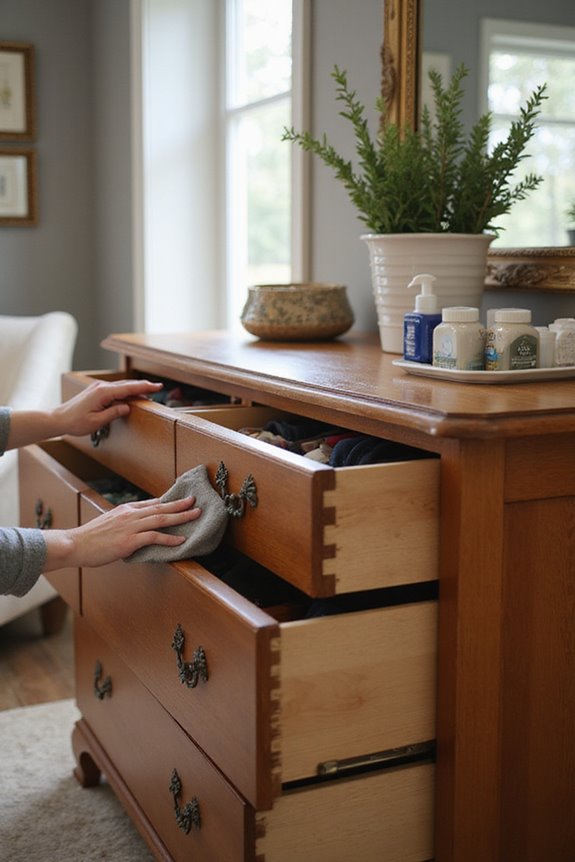
Cleaning and inspecting your furniture is like giving it a little TLC before the big move! First up, you’ll want to tackle dust removal. Grab a vacuum and a soft cloth—trust me, your furniture will thank you later. Don’t forget those pesky high-touch areas; they love to collect dirt. Did you spot any stains? A steam cleaner could be your new best friend!
After cleaning, it’s time for a damage assessment. Carefully inspect each piece for scratches or dings. You wouldn’t want your beloved chair to get further damaged during transit, right? Make a note of any fragile parts that need special handling, and consider grabbing some mild cleaners to avoid ruining surfaces. Got some stubborn residue? A baking soda mix can save the day! Additionally, ensure to check for material quality considerations that might affect the durability of your furniture during the move.
Disassembling Large Pieces
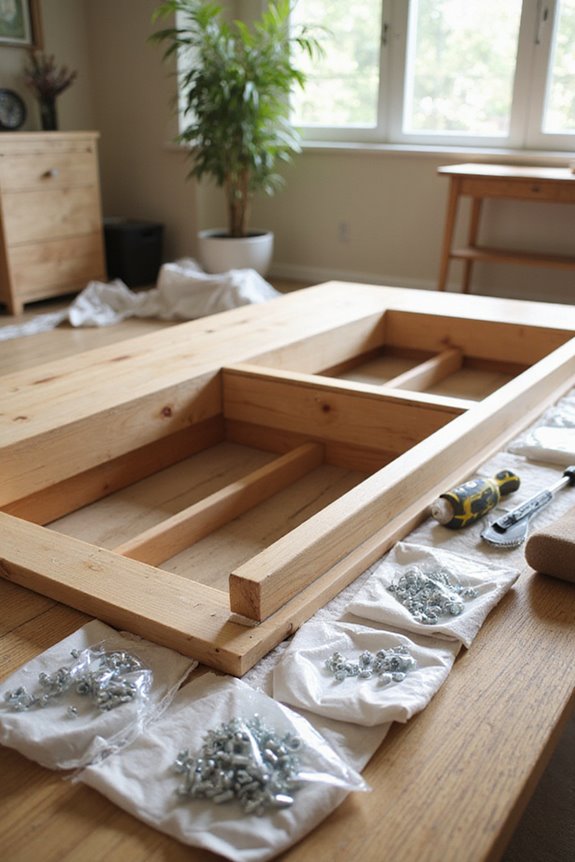
Now that your furniture is spotless and ready for its new adventure, it’s time to tackle those larger pieces! You’ll need some disassembly tools like screwdrivers and wrenches. Got those? Perfect! Before you get started, grab your furniture manuals or look online for specific disassembly instructions.
Start by removing legs from sofas or dressers to make them easier to move. Don’t forget to unscrew doors from cabinets—this helps avoid damage. Got heavy items? Grab a buddy! Sharing the load keeps you safe and stress-free. Label each part as you go; trust me, you’ll thank yourself later! Additionally, ensure that you handle vintage storage benches with care, as their construction often includes delicate elements like hinges or decorative hardware. So, are you ready to get started? Let’s make disassembly a breeze!
Creating an Inventory List
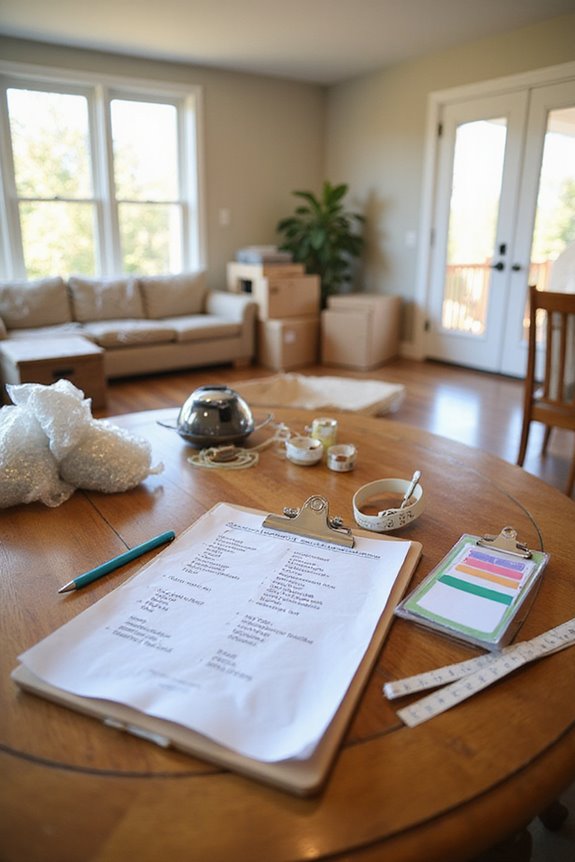
Before you plunge into the moving chaos, let’s talk about creating an inventory list! It’s not just smart; it saves your sanity! An inventory helps with accurate quoting and keeps track of everything. Are you thinking about what to include? Utilize templates in Excel or Google Sheets for item descriptions and conditions. Have you considered room assignments? They’ll guide where each piece goes in your new home!
Don’t forget item valuation—record original prices and purchase dates. This is essential for insurance claims! And hey, catching up on inventory tracking keeps everything organized and efficient. So grab your favorite drink, and let’s get to work on that list—it’s your best friend during the move! Excited yet? You should be! Additionally, consider the weight capacity of your furniture when documenting, as it can affect your moving logistics and insurance estimates.
Gathering Protection Supplies
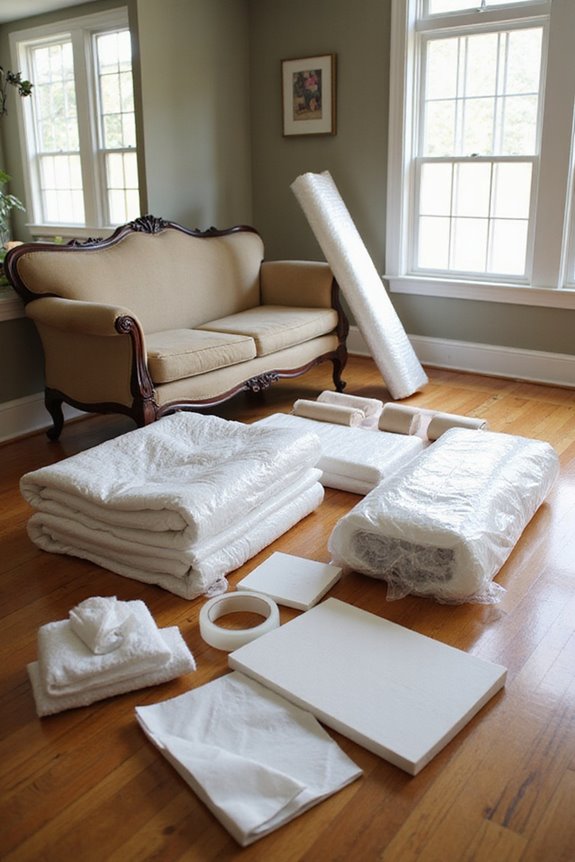
You’ve tackled your inventory list, and now it’s time to think about keeping your furniture safe! Start by gathering essential protection supplies. Have you thought about furniture pads? They’re fantastic for protecting large items from scratches and dents. Bubble wrap is a must for anything delicate—like those lovely glass elements on your furniture.
Don’t forget about plastic covers; they keep dirt and damage at bay. You could even use blankets as a budget-friendly substitute! Plastic tarps can be great for covering sofas and mattresses during transport. The more prepared you are, the smoother your move will go! So, which supplies will you pick up first? Remember, your furniture deserves the best care possible!
Utilizing Proper Wrapping Techniques
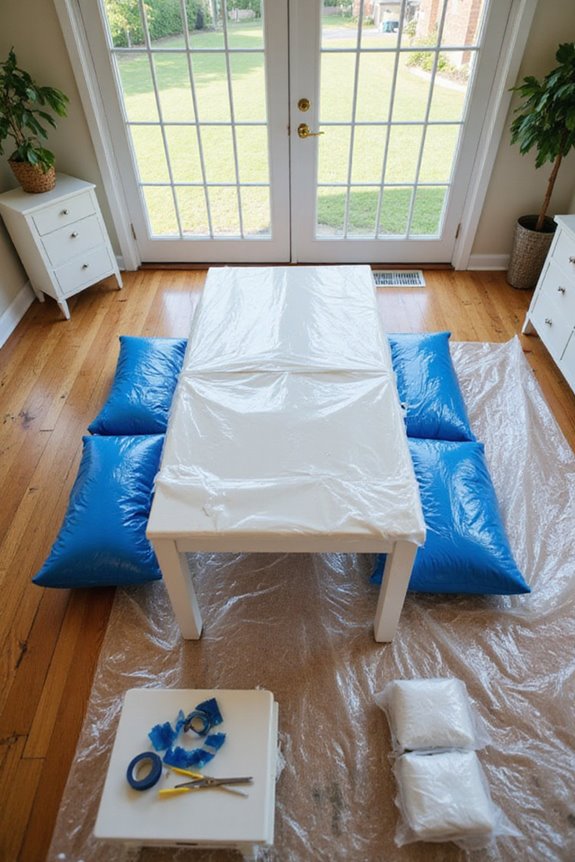
When it comes to wrapping your furniture, proper techniques can make all the difference, especially if you want to avoid damage during your move! Start with layered wrapping. Using multiple moving blankets provides great padding for your upholstered furniture. Don’t forget about edge protection! Secure those vulnerable corners with corner protectors to prevent any nasty dents.
Now, wrap everything uniformly. You want to make sure your furniture’s got a snug fit. Use plastic stretch wrap to keep those blankets in place and guard against moisture. For extra cushioning on fragile surfaces, grab some bubble wrap! Finally, secure everything with packing tape. You’ve got this! With these methods, your furniture will arrive safe and sound, ready for its new home.
Preparing Specific Furniture Types
Whether you’re moving across town or across the country, preparing specific furniture types for the big move can feel overwhelming. For bed frame preparation, start by disassembling the frame. This makes it lighter! Don’t forget to protect those exposed parts with moving pads. And hey, keep all screws in labeled bags—trust me, you don’t want them scattered!
Now, let’s talk about sofa protection. Remove those cushions and wrap them separately. Then, stretch wrap your sofa to keep it secure during the ride. You want your comfy couch arriving in one piece, right? Finally, think about your dining table and desks—removing legs doesn’t just make them easier to move; it saves space too. Happy packing!
Safely Handling Fragile Items
Packing up your home is fun, but what about those delicate items that make your space feel extra special? You’ll want to master fragile packing! Start by investing in high-quality bubble wrap and heavy-duty blankets. These protective materials will cushion your treasures and prevent scratches. Don’t forget to use sturdy, double-walled boxes! They’re perfect for keeping fragile furniture secure.
When wrapping, apply double layers of bubble wrap and label your boxes clearly. By doing this, you’re telling everyone to handle with care! Got a glass vase? Wrap that separately and use corner protectors. Remember—packing is all about layers. Fill any empty spaces with packing peanuts to keep everything snug. It’s like giving your fragile items a cozy blanket for their journey!
Final Preparations Before Moving
Getting ready to move can feel like a whirlwind, but don’t worry—there are some easy steps to make it a breeze! First things first, think about inventory management. Create a list that breaks down everything by room and item. A quick walk-through will help you verify nothing’s overlooked! Did you remember to document your furniture’s condition? Snap some photos of electronics before disassembling them; it’ll save you headaches later.
Now, let’s talk logistics coordination. Confirm your moving date and time, and check in with your neighbors. Arrange for parking to avoid chaos. Last but not least, take a final stroll through your house to make certain you’ve packed everything. Are you ready for this next adventure?
Frequently Asked Questions
How Do I Choose a Moving Company for Long-Distance Moves?
When choosing a moving company for long-distance moves, consider tips like checking licensing, reading consumer reviews, and evaluating services offered. Don’t forget long distance considerations, such as costs and insurance for your belongings.
What Items Should I Avoid Packing With My Furniture?
You shouldn’t pack perishables, electronics, or valuable items with your furniture. These can add unnecessary weight and risk damage. Instead, use appropriate packing materials to keep your furniture safe and separated from sensitive items.
How Can I Keep Furniture Clean During Transport?
You might think keeping furniture clean during transport is tough, but it’s not! Start with thorough cleaning, use shrink wrap for dust protection, and add moving blankets to guarantee everything stays spotless while in transit.
What Should I Do if Furniture Gets Damaged During Moving?
If your furniture gets damaged during the move, document everything immediately. Explore your insurance options, and consult your moving company about damage prevention measures for future relocations to minimize risks next time.
How Far in Advance Should I Start Preparing My Furniture for Moving?
You should start preparing your furniture at least 2-3 months in advance. Create a packing timeline and follow a moving checklist to guarantee you’re organized and ready when the moving day arrives.





